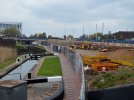Heartland
master brummie
The flight of locks from Curzon Street leading up to Ashted Canal Tunnel has undergone a change in recent times, as the former industrial premises were demolished and new properties are erected. Near the canal side the Unversity Locks Building provides accommodation for students and the former Canal Cottage which belonged to Fred Groves stands alone.
Leading up to Ashted Tunnel there is a new development called Glasswater Locks whose name is partly derived from the former Belmont Glassworks that stood above the tunnel. No points out of ten should be given to the person who thought up that title or the architects who have determined to line the towpath and offside of the locks with high-rise buildings.
Those that created the titles of this development, that is Glasswater Tower, Curzon Wharf, Cardigan Wharf, Belmont Wharf, Ashted Wharf, and the Cameo Works. may have drawn inspiration from consulting on line the ordnance survey, but have done little to follow the history of the area.
It is true that the Belmont Glassworks occupied the land above Ashted Tunnel and there was also a pottery here for a brief period. The site they are presently excavating near the tunnel was the location of a canal-pumping engine house now totally lost. The buildings adjacent were once part of the Electricars Ltd works before they moved to Hall Green and after the slump of 1922. Electricars Ltd was a pioneer in making electric cars, trucks, refuge vehicles, and electric delivery vehicles and the Lawley Street factory was a key part of that company's development.
When the Belmont Glassworks closed, part of the site became a timber yard, then the Coop built a bakery on the site and Electricars supplied delivery vehicles to the Co-op.
There is much more historical information out there, but seemingly the developers do not care. They may well have an eye on the massive profits they can make from these buildings when completed. As to glasswater is there such a word in the English language?

Leading up to Ashted Tunnel there is a new development called Glasswater Locks whose name is partly derived from the former Belmont Glassworks that stood above the tunnel. No points out of ten should be given to the person who thought up that title or the architects who have determined to line the towpath and offside of the locks with high-rise buildings.
Those that created the titles of this development, that is Glasswater Tower, Curzon Wharf, Cardigan Wharf, Belmont Wharf, Ashted Wharf, and the Cameo Works. may have drawn inspiration from consulting on line the ordnance survey, but have done little to follow the history of the area.
It is true that the Belmont Glassworks occupied the land above Ashted Tunnel and there was also a pottery here for a brief period. The site they are presently excavating near the tunnel was the location of a canal-pumping engine house now totally lost. The buildings adjacent were once part of the Electricars Ltd works before they moved to Hall Green and after the slump of 1922. Electricars Ltd was a pioneer in making electric cars, trucks, refuge vehicles, and electric delivery vehicles and the Lawley Street factory was a key part of that company's development.
When the Belmont Glassworks closed, part of the site became a timber yard, then the Coop built a bakery on the site and Electricars supplied delivery vehicles to the Co-op.
There is much more historical information out there, but seemingly the developers do not care. They may well have an eye on the massive profits they can make from these buildings when completed. As to glasswater is there such a word in the English language?



